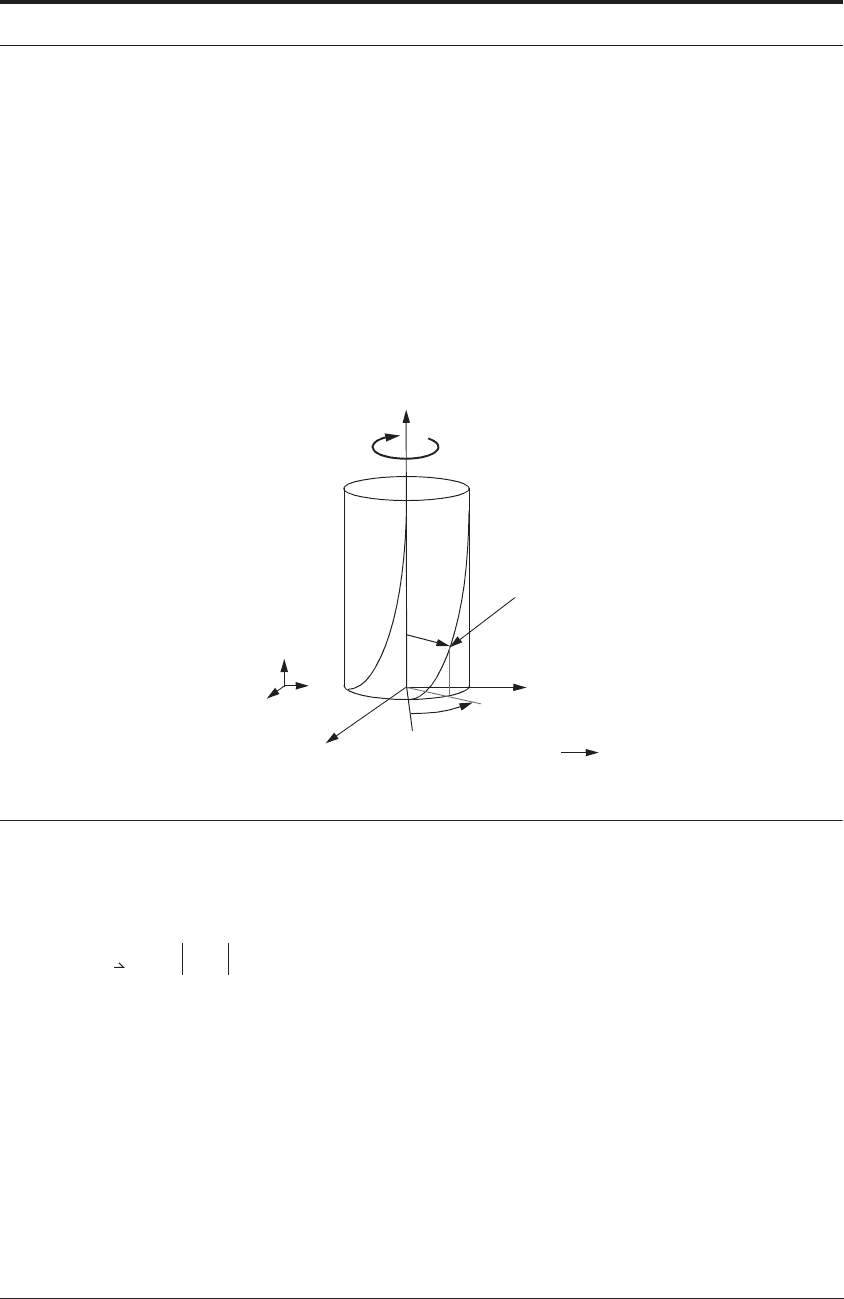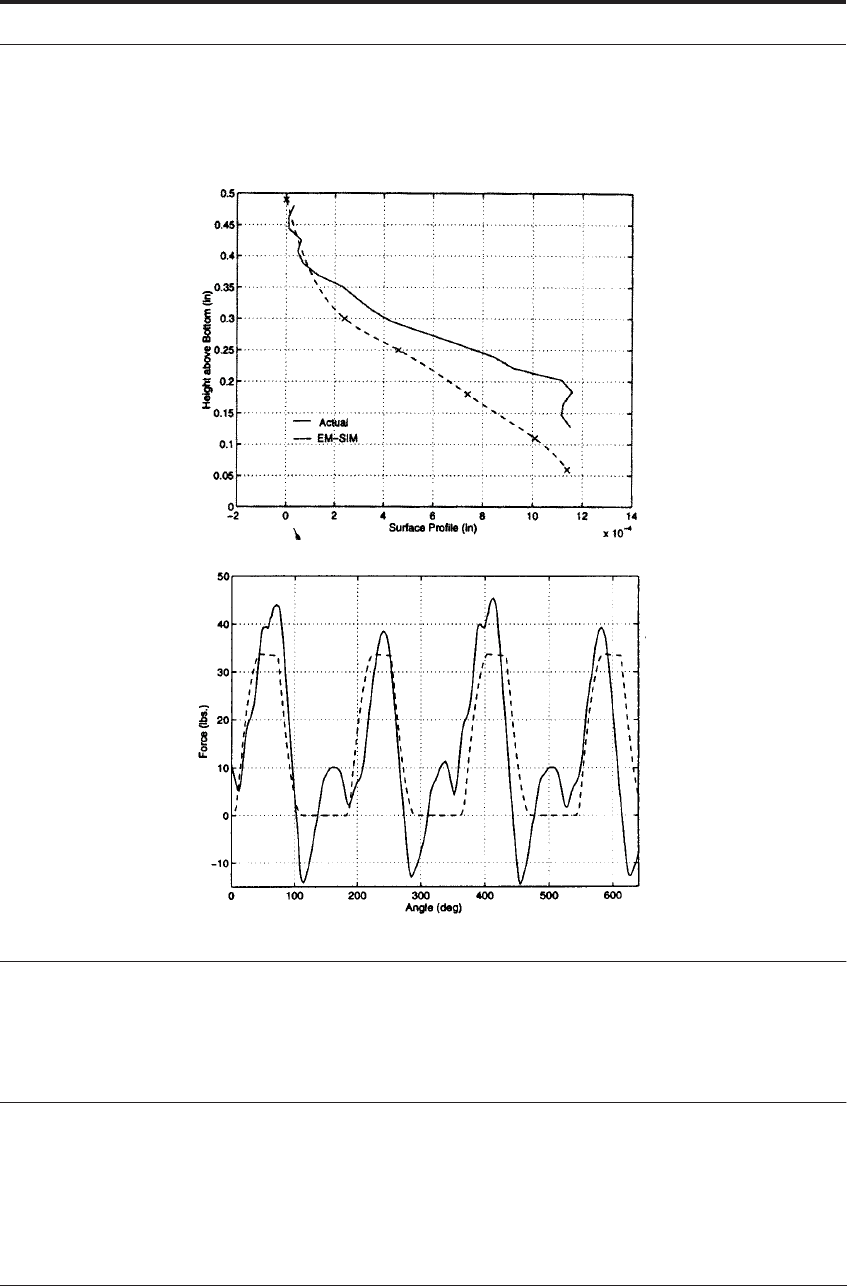Trent E.M., Wright P.K. Metal Cutting
Подождите немного. Документ загружается.


EMPIRICAL MODELS 373
12.2 EMPIRICAL MODELS
12.2.1 Introduction
Given the interaction between and the four parameters in the above list, it has not been sur-
prising that the research community has continued to persevere with their efforts and have
approached the overall modeling issue in two basic ways:
1. Spending great amounts of time in trying to find a theoretical method that might predict ,
and consequently the other parameters
2. Abandoning the search for -predictions and developing empirical or mechanistic models
that do not depend on first finding a value of . This was certainly Taylor’s style in the early
1900s. He knew that tool life vs. cutting speed was crucial to operating his factories efficiently.
Therefore he set his staff to machine enormous quantities of steel with a wide variety of tools
and eventually arrive at the famous Taylor Equation. It is a totally empirical model that relates
the cutting speed, V, and tool life, T, with the exponent n and constant C. These are particular to
each tool-work combination.
(12. 1)
Plotted on log-log axes, a straight line is obtained for most tool-work combinations:
FIGURE 12.2 Double log plot of tool life vs. cutting speed
The American Society of Metals Handbook (Volume 3 - Machining), and Metcut Research
Associates’ Machining Data Handbook, include tabulated data for a wide range of potential
work materials and their values of n and C. In addition, standard reference tables on recom-
mended speeds and feeds for a wide variety of operations are given. All such data is empiri-
cal.
6,7
Armarego and colleagues have probably created one of the most comprehensive data concern-
ing other parameters. These are based on practical machining operations from which average
forces and torque trends have been curve fitted using multivariable regression analysis. These
provide empirical-type equations involving all the relevant operation variables. It has been
φ
φ
φ
φ
VT
n
C=
log T
log V
1
n
General observation
= straight line
C

374 MODELING OF METAL CUTTING
found that these equations can greatly simplify the average force and torque predictions for a
wide variety of milling, drilling and oblique cutting operations.
8-11
Armarego has used these empirical-type equations in the development of constrained optimi-
zation analyses and software for selecting machining conditions (e.g. feed and speed) for opti-
mum economic performance. Furthermore the equations have been used to select the tool
geometry for improved (lower) forces and power requirements.
Examples of these equations are given in recent review papers.
12
The processes considered
include: a) high speed steel, point-thinned general purpose drills, b) high speed steel, end-mill-
ing cutters and c) flat-faced turning tools used to machine S1214 free machining steel. The chip
flow angle with respect to the straight major cutting edge for the lathe tools has also been
included in the empirical equations.
10
Similar equations have been established for face milling
with TiN coated carbide inserts.
11
In summary, these empirical equations, or models, allow a wide range of problems to be
addressed. Once the experimental work has been put in place to establish the exponents and con-
stants in the equations, they can be used by production personnel to set up and operate their
machines.
From a pure research viewpoint, the empirical approach is sometimes criticized for relying on
the original laboratory testing data. It is pointed out that the data are obtained under specific con-
ditions which may not translate to the equally specific but slightly different conditions on a fac-
tory machine tool. As shown in Chapter 9, only minor changes to a calcium deoxidation
procedure can make a big difference to tool life. On the other hand all modeling methodologies
are prone to this criticism - whether they be analytical models, mechanistic models or FEA mod-
els, no matter how good the supposed model is. First, if the chosen inputs to the model do not
match the conditions in practice, the “forecast” will be uncertain. Second, if the “internals” of
the model do not embody the correct material constitutive equation, or have no way of account-
ing for the frictional variations through the secondary shear flow zone, then again the “forecast”
will be uncertain.
Given this broader view, the empirical models in the Handbooks and in work such as Armar-
ego’s are extremely useful to the practitioner. This is all the more true, if the “forecasts” from the
empirical testing are seen as “starting points” for operation. In the Handbooks in particular the
recommended values of “n and C” are deliberately conservative. The personnel setting up the
machine can be confident that no major damage will occur to tools or components. And then,
“once things are stable on the machine” the cutting speed and feed can be prudently increased, if
so desired, to increase productivity.
12.3 REVIEW of ANALYTICAL MODELS
From Chapters 4 and 15, three closed-form analytical models are summarized below:
12.3.1 The Merchant model
When the minimum energy principle is applied, the shear plane angle is predicted to be:
η
c

MECHANISTIC MODELS 375
(12. 2)
where = shear angle; = rake angle; λ = friction angle
12.3.2 The Oxley model
The angle that the resultant cutting force makes with the shear plane is:
(12. 3)
12.3.3 The Rowe-Spick model
When the minimum energy principle is applied, the shear plane angle is predicted to be:
(12. 4)
= a constant between zero and one (not a friction angle). The value of χ is related to
In the above, L is the chip-tool contact length. The family of curves in Figure 4.10 shows that,
as the contact length on the rake face of the tool increases, the minimum energy occurs at lower
values of the shear plane angle and the rate of work done increases greatly. Friction, and more
specifically seizure, play a great role in metal cutting and all models should consider it in detail.
Even though these closed-form analytical solutions were developed several years ago, the new
student in the field is encouraged to review them in detail. When considered in the context of
Figure 4.10 they give great insight into the physics of cutting - i.e. the effect of rake angle and
friction. Sandstrom’s Java applet is highly recommended here.
13
12.4 MECHANISTIC MODELS
12.4.1 Introduction
Following the early work by Koenigsberger and Sabberwal,
14
DeVor and colleagues have
employed mechanistic methods over the past twenty years to model three-dimensional cutting
processes such as milling and drilling. The underlying assumption behind their mechanistic
methods is that the cutting forces are proportional to the uncut chip area. The constant of pro-
portionality depends on the cutting conditions, cutting geometry and material properties. This
section aims to give a general overview of the model-building methodology for these models.
The review is based on a recent thesis by Stori, and his paper with King and Wright.
15,16
φπ4⁄α2⁄λ2⁄–+=
φα
θ
θφλα–+=
α 2φα–()coscos βχ φsin
2
–0.=
β
L χ OP()=
L χ
t
1
αcos
------------
=

376 MODELING OF METAL CUTTING
12.4.2 Component accuracy - EMSIM
The “end-milling simulation” - EMSIM - uses a mechanistic model of the end-milling process
for the prediction of cutting forces and tool deflections. This “indented-ski-slope” deflection is
schematically shown in Figure 2.6. For the analysis, the flutes of the end-mill are decomposed
into thin axial slices (in a class situation it is useful to pile-up a column of pennies, or coins, rep-
resenting the sliced up end-mill). Force elements for each slice are then summed to predict the
instantaneous cutting force. This mechanistic force model was developed by Kline, DeVor et
al.
17-21
The elemental force components in the tangential and radial directions are shown in Fig-
ure 12.3, and can be expressed as:
(12. 5)
(12. 6)
K
t
´ and K
R
are empirical coefficients for the work material and tool material. D
z
is the thick-
ness of the axial disk. Also, t
c
is the instantaneous chip thickness going around the arc-shaped
slice. Examination of Figure 12.3 shows that as the tool edge first “bites into” the surface labeled
“B”, the instantaneous value of t
c
will be the same as the feed rate (f). But as the tool cuts around
the arc to “A”, it encounters a thinner and thinner instantaneous value of t
c
.
In the ideal case, the instantaneous value of chip thickness t
c
is approximated
15
by (t
c
=fsin α),
where f is the feed per tooth, and α is the angular position of the tooth in the cut, shown in Figure
12.3. However, the presence of runout greatly complicates the estimation of the instantaneous
chip thickness. Runout occurs if the cutting tool axis is not perfectly aligned with the tool-holder
and machine tool spindle. When the combined system spins around, the very tip of the tool
might thus create two errors. It might vibrate back-and-forth {the case of parallel axis offset
runout (PAOR)}, or it could scribe out a cutting circle on an axis that tilts relative to the tool’s
axis {the case of axis tilt runout (ATR)}.
For the basic case without runout, the angular position, α, of a tooth in the cut can be computed
for each axial disk element, i, and flute, k. The i value will be an integer value depending on the
number of axial slices used in the EMSIM run. A typical end-mill will have two or four flutes,
thus k will be 1, 2, 3, or 4. In the equation below, the j value can be regarded as an integer value
that “counts around” the arc during the computer simulation. So, for the simple case of the first
slice and first flute, i = 1, and k = 1. Then, the first term on the right side of the equation below is
one where θ(j) “counts around” the arc in Figure 12.3 by (say) 100 integer steps. The second
term in the {braces} on the right side of the equation is the vertical height of the engagement
point above the bottom of the disc being analyzed. Again, to show a simple case, the first disc is
i = 1 so the term in the square [brackets] becomes (D
z
/2) which is just the mid-point of that first
disc. This is multiplied by (tan(
λ)/R) to account for the helical twist. (Note, out of interest, if
there were no twist, the mill would be a reamer with straight edges - and α would just track
around in the same position as θ.
(12. 7)
F
t
i()δ K′
t
D
z
t
c
=
F
R
i()δ K
R
δF
t
=
α ijk,,()θj() γk 1–()+[]i 1–()D
z
D
z
2⁄+[]λ()tan R⁄{}+=

MECHANISTIC MODELS 377
In the above, γ is the angular spacing between flutes on the cutter, θ is the angular orientation
measured in the same direction as α, and λ is the helix angle of the cutter. Another relationship
that helps to understand the relative angles is (t
c
= Rθ/tanλ).
FIGURE 12.3 “Axial slices” through the “climb” end milling process.
DOC
DOC
WOC
WOC
Cross-section of flute orientation
z 0=
z DOC 2⁄=
z DOC=
z
WOC
f
θ
A
B
B
A
F
t
δ
F
r
δ

378 MODELING OF METAL CUTTING
For the prediction of the maximum surface form error, forces tangential to direction of feed
(F
y
) must be considered. In Figure 12.3 the projection of the elemental force components F
t
, and
F
R
onto the y-axis (acting away from the wall being machined) can be expressed as follows:
(12. 8)
The tangential cutting force, F
y
, is obtained by summing the elemental force contributions of
all of the flutes engaged in a cut along the extent of the cut. The contributions for each of the
flutes must be considered when α
ex
≤ α(i,j,k) ≤ α
en
, where α
en
and α
ex
are the entrance and exit
angles, respectively, for the cut. The exit angle is approximately zero, α
ex
=0, and the entrance
angle is a function of the radial width of cut (WOC) and the tool radius (R).
(12. 9)
Although in restricted cases the cutting forces may be obtained through a closed-form inte-
gration of equation 12.7, this becomes impossible as complications such as runout are intro-
duced into the model. For this reason, EMSIM is implemented as a computer simulation based
upon the elemental force contributions.
The prediction of the “ski-slope” effect is accomplished through a cantilever beam model for
end-mill deflection. The instantaneous tangential cutting force is applied using a cantilever beam
model at the force center of the distributed cutting forces. The surface error is taken to be the
deflection of the tool at the point of contact between the cutter tooth and the finished surface.
This is best visualized at the bottom of a pocket being cut. This point of contact is known as the
surface generation point, SG. The form error at the surface generation point may be then
expressed as follows:
(12. 10)
L is the distance of the surface generation point from the fixed end of the cantilever beam.
Usually this is where the milling tool clamps into the tool holder. E and I are the Young’s modu-
lus and moment of inertia of the end mill, respectively. The force center, CF
y
, is a virtual point of
application. It represents a point-force load that would cause the equivalent bending moment
about the tool holder as the actual distributed-force load which acts along the milling tool’s side.
The surface generation point is correlated with the angular position of the cutter, θ, by:
(12. 11)
Recent results are at http://madmax.me.berkeley.edu/webparam/demo2/summary2.html.
δF
y
ijk,,()F
t
ijk,,()δαijk,,()()sin F
R
δ+ ijk,,()αijk,,()()cos=
α
en
1 WOC R⁄–()acos=
Δ
ˆ
SG()
F
y
CF
y
2
3CF
y
L–()
6EI
---------------------------------------------=
SG R θ⋅λ()tan⁄=

MECHANISTIC MODELS 379
12.4.3 Component surface roughness - SURF
The “surface of the wall” generated by the peripheral cutting edges on an end mill has been
modeled by Babin et al.
22,23
, and an analytical solution has recently been developed by Melkote
and Thangaraj.
24
This latter model is described below. Once again the reader might glance back,
this time to the face XY in Figure 2.7, to identify the area under discussion.
Figure 12.4 shows the geometry of a typical end mill with a right hand helix. The end mill is
modeled as a cylindrical surface of nominal radius R with N
t
helical cutting edges on its periph-
ery. The cutter is assumed to rotate and translate as shown in the figure. The final machined
surface, assumed to be generated by the combined effect of the two motions, is described by the
trochoidal path followed by the cutting edges.
FIGURE 12.4 Milling geometry in ideal case with no runout. The tool rotates around Z
c
perfectly aligned
with the machine tool Z
s
. Feed is then X and Y.
The position vector of a point P on the i
th
cutting edge is given by:
(12. 12)
where f is the cutter feed, θ
rot
is the rotation angle, λ is the helix angle, and
(12. 13)
The angle θ
p
is the circular pitch of cutter teeth and the angle u represents the phase difference
between the leading and trailing edges of the i
th
cutting edge due to the helix. The tooth path
segments at a particular cutter axial location are determined by the intersections between the tra-
jectories traced by successive teeth. The multiple intersections are found analytically from the
multiple values of θ
rot
at which the intersections occur:
Direction
of cutter
rotation
Z
C,
Z
S
Y
C
,Y
S
X
C
, X
S
X
Y
Z
Feed
direction
Point P
R
u
P
f θ
rot
2π
---------------- R
i
θ
i
u+()cos+
⎩⎭
⎨⎬
⎧⎫
i
ˆ
R
i
θ
i
u+()sin{}j
ˆ
R
i
u
λtan
-----------
⎩⎭
⎨⎬
⎧⎫
k
ˆ
++=
θ
i
θ
rot
i 1–()θ
p
+=

380 MODELING OF METAL CUTTING
(12. 14)
where n = 0, 1, 2, 3... represents the number of cutter revolutions.
The ideal three-dimensional milled surface can be generated using the equations above and
surface roughness parameters such as R
a
, R
q
, and R
max
can then be computed from the profile
data at any location along the cutter axis.
12.4.4 Roughness including runout
Eccentric motion of the cutter when mounted in the spindle can lead to runout - parallel axis
offset runout (PAOR) and axis tilt runout (ATR). In Figure 12.5, the parameters e and β repre-
sent the magnitude and direction, respectively, of the cutter axis offset. In Figure 12.6 axis tilt
runout is represented by τ (magnitude) and ρ (direction). To generate a 3-D map of the modeled
surface, the paths of discrete points, P
k
, along each flute of the cutter must be determined. The
cutter is divided into k discrete axial slices. For each slice, the position of the point P
k
is found as
the cutter is rotated through a complete revolution. This procedure is applied to each flute on the
cutter varying k over the entire axial cut. Each point P
k
is a position vector in an XYZ coordinate
system:
(12. 15)
where x
k
, y
k
, and z
k
are determined as:
(12. 16)
(12. 17)
(12. 18)
where θ
i
in the above expressions defines the angle from the X axis to each flute, i, at the free
end of the cutter:
(12. 19)
where i is varied from 0 to 3 for a cutter with four flutes. To determine the surface profile at
each axial depth k, successive tooth path intersection points are found. The 2-D profile is defined
θ
rot
ui1–()θ
p
f θ
p
2nπ+()
4Rπ
-----------------------------
acos++=
P
k
x
k
i y
k
j z
k
k++=
x
k
fφ
2π
------ r
t
θ
i
α–()cos εφβ+()cos l
t
z
k
–()τsin φρ+()cos+++=
y
k
r
t
θ
i
α–()sin εφβ+()sin l
t
z
k
–()τsin φρ+()sin++=
z
k
2r
t
2
1 αcos–()
λtan
---------------------------------------=
θ
i
φ iθ
p
–=

MECHANISTIC MODELS 381
by the points that connect the intersections. The 2-D profile is determined for each axial slice,
then all slices are combined to form the 3-D surface map.
FIGURE 12.5 End milling with run out - top view
FIGURE 12.6 End milling with runout - side view (Figures 12.3 to 12.6 from Stori, King and Wright)
12.4.5 Case study: results from EMSIM
Figure 12.7a shows good agreement between EMSIM predictions and probing results for the
form-error on the walls of a pocket machined in 6061 aluminum with a 0.5 inch high speed steel
cutter.
25
Other results in the same set of experiments showed good agreement on forces (Figure
12.7b). Over time, these models are improving in their accuracy and scope, and can now be used
by practitioners to obtain higher accuracy in processes such as end milling. Knowing the pre-
dicted deflection in Figure 12.7a, allows the “roughing and finishing” sequence of the CNC
program to be closer to the “desired line” on the component being cut. However, the shape of
the contour will not change unless additional finishing passes are used to “trim out” the inside
X
Y
P
k
i
i+1
i+2
i+3
f
r
x
c
x
c
'
x
c
''
y
c
θ
p
β
ρφ
ε
(
l
t
-
z
k
)
s
i
n
τ
α
r
t
f
r
X
Y
x
c
y
c
z
c
Z
l
t
P
k
τ
z
k
α
φ

382 MODELING OF METAL CUTTING
corner of the pocket, where material might remain from a first finishing pass. This has to be done
with care to ensure that the pocket is not “overcut” at the top surface.
FIGURE 12.7 a) Contour plots showing the form error from equation 12.10. b) Comparisons between
experimental forces (solid lines) and predicted forces (dashed lines from EMSIM). Results of Mueller,
DeVor and Wright. Also see - http://madmax.me.berkeley.edu/webparam/demo2/summary2.html
12.5 FINITE ELEMENT ANALYSIS BASED MODELS
12.5.1 General introduction
For illustration purposes, Figure 5.7 is repeated below next to a finite element mesh (Figure
12.8). On the left, the classical equations developed in texts such as Carslaw and Jaeger
26
create
a continuum situation. By contrast, on the right, the finite element mesh, first used in this form
for metal cutting by Tay et al,
27
creates a discretized situation. Here, many small, interconnected
